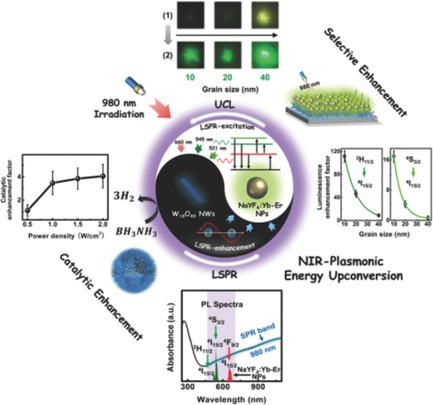Our official English website, www.x-mol.net, welcomes your
feedback! (Note: you will need to create a separate account there.)
Near‐Infrared‐Plasmonic Energy Upconversion in a Nonmetallic Heterostructure for Efficient H2 Evolution from Ammonia Borane
Advanced Science ( IF 14.3 ) Pub Date : 2018-07-03 , DOI: 10.1002/advs.201800748 Zhenyi Zhang 1 , Yang Liu 1, 2 , Yurui Fang 3 , Baosheng Cao 1 , Jindou Huang 1 , Kuichao Liu 1 , Bin Dong 1
Advanced Science ( IF 14.3 ) Pub Date : 2018-07-03 , DOI: 10.1002/advs.201800748 Zhenyi Zhang 1 , Yang Liu 1, 2 , Yurui Fang 3 , Baosheng Cao 1 , Jindou Huang 1 , Kuichao Liu 1 , Bin Dong 1
Affiliation

|
Plasmonic metal nanostructures have been widely used to enhance the upconversion efficiency of the near‐infrared (NIR) photons into the visible region via the localized surface plasmon resonance (LSPR) effect. However, the direct utilization of low‐cost nonmetallic semiconductors to both concentrate and transfer the NIR‐plasmonic energy in the upconversion system remains a significant challenge. Here, a fascinating process of NIR‐plasmonic energy upconversion in Yb3+/Er3+‐doped NaYF4 nanoparticles (NaYF4:Yb‐Er NPs)/W18O49 nanowires (NWs) heterostructures, which can selectively enhance the upconversion luminescence by two orders of magnitude, is demonstrated. Combined with theoretical calculations, it is proposed that the NIR‐excited LSPR of W18O49 NWs is the primary reason for the enhanced upconversion luminescence of NaYF4:Yb‐Er NPs. Meanwhile, this plasmon‐enhanced upconversion luminescence can be partly absorbed by the W18O49 NWs to re‐excite its higher energy LSPR, thus leading to the selective enhancement of upconversion luminescence for the NaYF4:Yb‐Er/W18O49 heterostructures. More importantly, based on this process of plasmonic energy transfer, an NIR‐driven catalyst of NaYF4:Yb‐Er NPs@W18O49 NWs quasi‐core/shell heterostructure, which exhibits a ≈35‐fold increase in the catalytic H2 evolution from ammonia borane (BH3NH3) is designed and synthesized. This work provides insight on the development of nonmetallic plasmon‐sensitized optical materials that can potentially be applied in photocatalysis, optoelectronic, and photovoltaic devices.
中文翻译:

非金属异质结构中的近红外等离子体能量上转换,用于从氨硼烷中高效析氢
等离激元金属纳米结构已被广泛用于通过局域表面等离激元共振(LSPR)效应提高近红外(NIR)光子到可见光区域的上转换效率。然而,直接利用低成本非金属半导体在上转换系统中集中和转移近红外等离子体能量仍然是一个重大挑战。这里,Yb 3+ /Er 3+掺杂的 NaYF 4纳米颗粒(NaYF 4 :Yb-Er NPs)/W 18 O 49纳米线(NWs)异质结构中近红外等离子体能量上转换的迷人过程,可以选择性地增强上转换证明了两个数量级的发光。结合理论计算,提出W 18 O 49纳米线的近红外激发局域表面等离子体共振是NaYF 4 :Yb-Er NPs上转换发光增强的主要原因。同时,这种等离子体增强的上转换发光可以被W 18 O 49 NW部分吸收,以重新激发其更高能量的局域表面等离子体共振,从而导致NaYF 4 :Yb-Er/W 18 O 49的上转换发光选择性增强异质结构。更重要的是,基于这种等离子体能量转移过程,近红外驱动的 NaYF 4 :Yb-Er NPs@W 18 O 49 NWs 准核/壳异质结构催化剂,其催化 H 增加了约 35 倍。 2.设计并合成了由氨硼烷(BH 3 NH 3 )演变而来的。 这项工作为非金属等离子体敏化光学材料的开发提供了见解,这些材料可潜在应用于光催化、光电和光伏器件。
更新日期:2018-07-03
中文翻译:

非金属异质结构中的近红外等离子体能量上转换,用于从氨硼烷中高效析氢
等离激元金属纳米结构已被广泛用于通过局域表面等离激元共振(LSPR)效应提高近红外(NIR)光子到可见光区域的上转换效率。然而,直接利用低成本非金属半导体在上转换系统中集中和转移近红外等离子体能量仍然是一个重大挑战。这里,Yb 3+ /Er 3+掺杂的 NaYF 4纳米颗粒(NaYF 4 :Yb-Er NPs)/W 18 O 49纳米线(NWs)异质结构中近红外等离子体能量上转换的迷人过程,可以选择性地增强上转换证明了两个数量级的发光。结合理论计算,提出W 18 O 49纳米线的近红外激发局域表面等离子体共振是NaYF 4 :Yb-Er NPs上转换发光增强的主要原因。同时,这种等离子体增强的上转换发光可以被W 18 O 49 NW部分吸收,以重新激发其更高能量的局域表面等离子体共振,从而导致NaYF 4 :Yb-Er/W 18 O 49的上转换发光选择性增强异质结构。更重要的是,基于这种等离子体能量转移过程,近红外驱动的 NaYF 4 :Yb-Er NPs@W 18 O 49 NWs 准核/壳异质结构催化剂,其催化 H 增加了约 35 倍。 2.设计并合成了由氨硼烷(BH 3 NH 3 )演变而来的。 这项工作为非金属等离子体敏化光学材料的开发提供了见解,这些材料可潜在应用于光催化、光电和光伏器件。











































 京公网安备 11010802027423号
京公网安备 11010802027423号